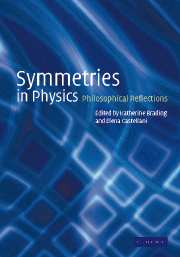Book contents
- Frontmatter
- Contents
- List of contributors
- Preface
- Copyright acknowledgements
- 1 Introduction
- Part I Continuous symmetries
- 2 Classic texts: extracts from Weyl and Wigner
- 3 On continuous symmetries and the foundations of modern physics
- 4 The philosophical roots of the gauge principle: Weyl and transcendental phenomenological idealism
- 5 Symmetries and Noether's theorems
- 6 General covariance, gauge theories, and the Kretschmann objection
- 7 The interpretation of gauge symmetry
- 8 Tracking down gauge: an ode to the constrained Hamiltonian formalism
- 9 Time-dependent symmetries: the link between gauge symmetries and indeterminism
- 10 A fourth way to the Aharonov–Bohm effect
- Part II Discrete symmetries
- Part III Symmetry breaking
- Part IV General interpretative issues
- Index
8 - Tracking down gauge: an ode to the constrained Hamiltonian formalism
Published online by Cambridge University Press: 08 October 2009
- Frontmatter
- Contents
- List of contributors
- Preface
- Copyright acknowledgements
- 1 Introduction
- Part I Continuous symmetries
- 2 Classic texts: extracts from Weyl and Wigner
- 3 On continuous symmetries and the foundations of modern physics
- 4 The philosophical roots of the gauge principle: Weyl and transcendental phenomenological idealism
- 5 Symmetries and Noether's theorems
- 6 General covariance, gauge theories, and the Kretschmann objection
- 7 The interpretation of gauge symmetry
- 8 Tracking down gauge: an ode to the constrained Hamiltonian formalism
- 9 Time-dependent symmetries: the link between gauge symmetries and indeterminism
- 10 A fourth way to the Aharonov–Bohm effect
- Part II Discrete symmetries
- Part III Symmetry breaking
- Part IV General interpretative issues
- Index
Summary
Introduction
Like moths attracted to a bright light, philosophers are drawn to glitz. So in discussing the notions of ‘gauge’, ‘gauge freedom’, and ‘gauge theories’, they have tended to focus on examples such as Yang–Mills theories and on the mathematical apparatus of fibre bundles. But while Yang–Mills theories are crucial to modern elementary particle physics, they are only a special case of a much broader class of gauge theories. And while the fibre bundle apparatus turned out, in retrospect, to be the right formalism to illuminate the structure of Yang–Mills theories, the strength of this apparatus is also its weakness: the fibre bundle formalism is very flexible and general, and, as such, fibre bundles can be seen lurking under, over, and around every bush. What is needed is an explanation of what the relevant bundle structure is and how it arises, especially for theories that are not initially formulated in fibre bundle language.
Here I will describe an approach that grows out of the conviction that, at least for theories that can be written in Lagrangian/Hamiltonian form, gauge freedom arises precisely when there are Lagrangian/Hamiltonian constraints of an appropriate character. This conviction is shared, if only tacitly, by that segment of the physics community that works on constrained Hamiltonian systems.
- Type
- Chapter
- Information
- Symmetries in PhysicsPhilosophical Reflections, pp. 140 - 162Publisher: Cambridge University PressPrint publication year: 2003
- 19
- Cited by



